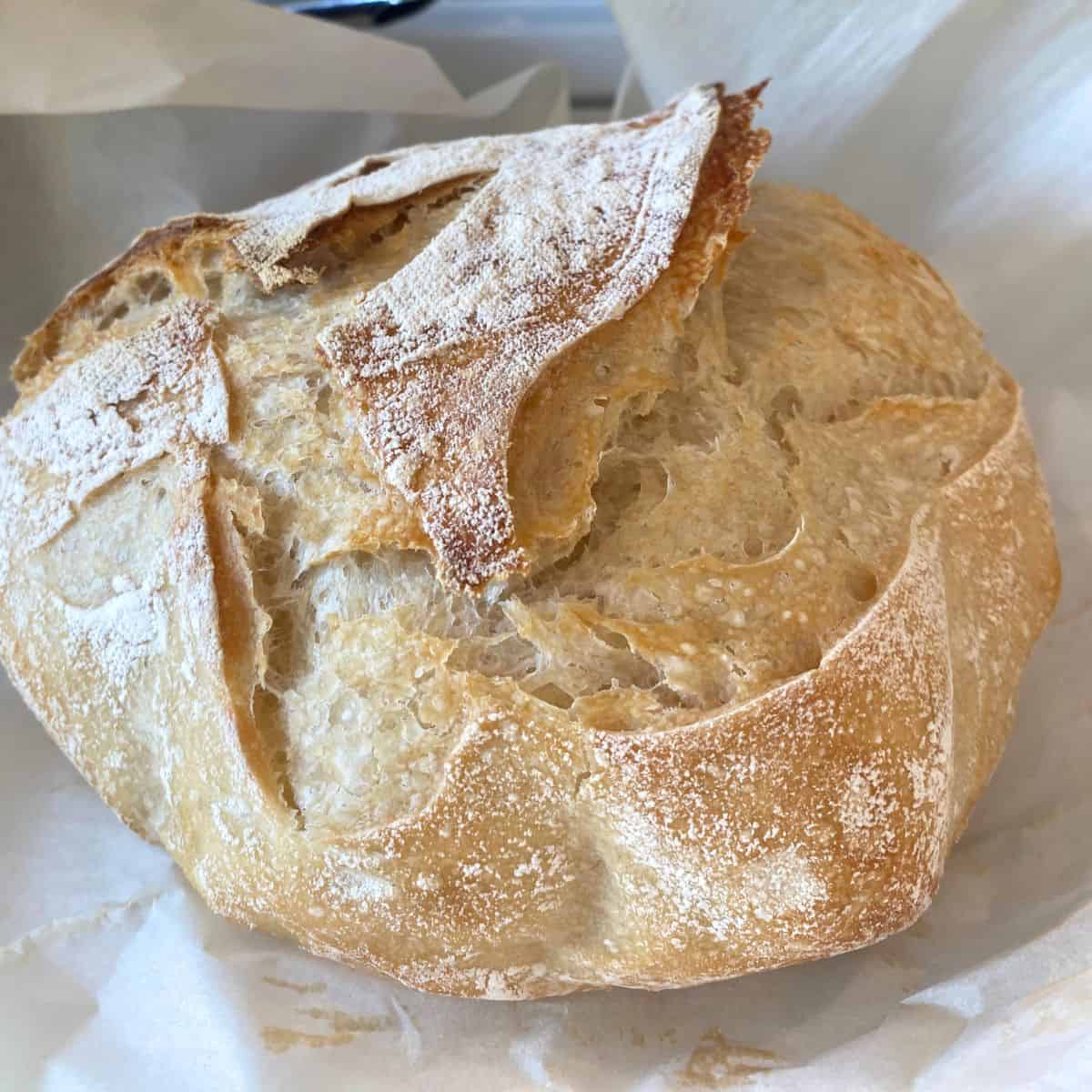This Sourdough Challah bread recipe isn’t your average challah – it’s a sourdough challah, which means we’re talking about a depth of flavor you just won’t find in store-bought challah bread!

Just like artisan sourdough bread… This is a slower paced bake, but trust me, every step of this sourdough challah bread is worth it! From nurturing your bubbly sourdough starter to the satisfying braid… And that first glorious bite! This homemade bread is truly special.
If you’re ready to take your sourdough baking skills to the next level, and bake a challah that will blow your mind, (and everyone else’s), then get baking!

Bread Flour & All-Purpose Flour
This Sourdough Challah recipe calls for a blend of strong bread flour and all-purpose flour. There is a reason for that… Strong bread flour, sometimes called high-gluten flour, is the champion when it comes to structure. It’s got tons of gluten, which is what gives our challah that beautiful rise and chewy texture. But, all bread flour can make a bread a little too chewy, almost tough…
That’s where all-purpose flour comes in. It’s a bit softer and adds just the right touch of tenderness. Blending the two gives you the best of both worlds: a good rise and structure from the bread flour, and a soft, fluffy crumb thanks to the all-purpose flour.
It’s the perfect balance for a truly amazing sourdough challah bread. This blend ensures our braided bread is sturdy enough to hold its shape and delightfully soft to eat! So, don’t skip the all-purpose… It’s key to that perfect challah texture. 😉

Sourdough Challah Bread Tips
Starter Health is Key: Your sourdough starter needs to be very active and bubbly for this recipe to work. If it’s sluggish, your dough won’t rise properly. Make sure it doubles in size after feeding before using it in the levain. If it’s not reliably doubling, you may need to adjust your feeding schedule or starter maintenance routine.
Temperature Matters: Fermentation is very influenced by temperature… The times given in the recipe are guidelines. A warmer kitchen will mean faster rising, and a cooler kitchen slower rising. Pay attention to the dough’s volume, not the clock. It should double during bulk fermentation. 😉 This is a long process. Don’t rush the steps… The long fermentation is what gives sourdough challah its sourdough flavor.
Don’t Overproof: Over-proofed challah will deflate in the oven. The proofing time is just a guideline. Look for a slightly puffy loaf that springs back slightly when gently poked. It shouldn’t feel overly soft or jiggly.

Kneading: Kneading (and stretch and folds) develop the gluten, which gives the challah its structure. Knead until the dough is smooth and elastic…It should pass the windowpane test (you can stretch a small piece thin enough to see light through it without tearing).
Braiding Takes Practice: Braiding challah can be tricky. Watch my video to learn the technique. Don’t be discouraged if your first few attempts aren’t perfect!
Recipe Card
If you make this delicious sourdough challah bread…. I’d really appreciate a review or recipe rating! Let me know if you have nay questions in the comments below;)

Fluffy Sourdough Challah Bread Recipe – Long Fermented Recipe
Ingredients
For the Sourdough Levain (Sourdough Starter)
- 100 grams sourdough starter mature (about 3/4 cup)
- 100 grams all purpose flour (about 3/4 cup + 2 tablespoons)
- 100 grams water (about ⅓ cup + 2 tablespoons)
For the dough
- 500 grams bread flour high gluten (about 4 cups)
- 100 grams all purpose flour (about 3/4 cup + 2 tablespoons)
- 75 grams sugar granulated white cane sugar (about 1/3 cup)
- 2 teaspoons salt
- 2 eggs large
- 1 egg yolk large
- 1/4 cup honey 60 ml
- 1/4 cup olive oil 60 ml
- 1 1/4 cup warm water 240 grams, lukewarm
- 1 cup ripe levain (sourdough starter from step 1, about 240 grams)
Instructions
Make the Levain
- In a clean bowl, combine the sourdough starter, flour, and water.
- Mix well until a smooth batter forms.
- Cover the bowl with plastic wrap or a damp cloth and let it rest at room temperature for 8-12 hours, or until bubbly and doubled in size.
Make the Dough
- In a large bowl, whisk together the bread flour, all-purpose flour, sugar, and salt. In a separate bowl, whisk together the eggs, egg yolk, honey, warm water and olive oil.
- Add the wet ingredients to the dry ingredients and mix until a shaggy dough forms.
- Stir in the ripe levain (sourdough starter).
- Knead the dough for 8-10 minutes by hand, or 5-7 minutes with a stand mixer fitted with a dough hook. The dough should be smooth and elastic.
- Place the dough in a lightly oiled bowl, turning to coat. Cover the bowl with plastic wrap or a damp cloth and let it rest at room temperature for 30 minutes.
Bulk Fermentation
- Gently shape the dough into a ball. Place the dough in a lightly oiled bowl, seam-side down.
- Cover the bowl with plastic wrap or a damp cloth and let it rise at room temperature for 4-6 hours, or until doubled in size.
- Perform 2-3 sets of folds at 30-minute intervals during the bulk fermentation. (To fold, gently stretch and fold the edges of the dough towards the center.)
Shaping
- Gently deflate the dough.
- Divide the dough into 6 equal pieces. Roll each piece into a rope about 18 inches long.
- Braid the ropes together in the traditional challah pattern (3 strands, 4 strands, or 6 strands).
- Place the braided loaf on a parchment-lined baking sheet. Cover loosely with plastic wrap or a damp cloth and let it rest for another 30-60 minutes.
Proof
- Preheat the oven to 375°F (190°C). Lightly brush the loaf with egg wash (1 egg yolk mixed with 1 tablespoon water).Sprinkle with sesame seeds, poppy seeds, or coarse salt (optional).Let the loaf proof for another 30-45 minutes, or until slightly risen.
Bake
- Bake the challah for 25-35 minutes, or until golden brown and the internal temperature reaches 190°F (88°C). Let the loaf cool on a wire rack for at least 30 minutes before slicing and serving.
Video
Notes
-
- Starter Activity: make sure your sourdough starter is active and bubbly before using it.
- Hydration: Adjust the water amount slightly depending on the flour you use and the humidity.
- Temperature Control: Maintain a consistent room temperature during fermentation.
Nutrition

About Juliea
Juliea Huffaker is the creator of Farmhouse Harvest, and dedicated to teaching from-scratch cooking, sourdough baking, gardening, and food preservation. With over 25 years of hands-on experience she has preserved hundreds of jars of produce, mastered the art of meats and sourdough baking, and nurtured a thriving organic garden. Her recipes and articles have been featured across the web. And she’s passionate about inspiring others to embrace a simpler, self-sufficient life style.








